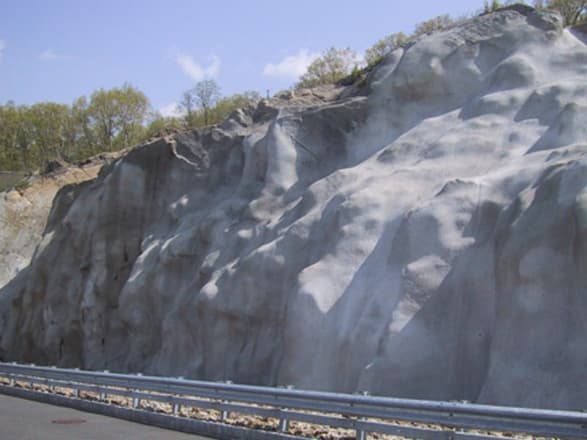SESI is hiring for Geotechnical, Environmental, and Site Civil positions. Apply Now!
SESI Learning Series: Rock Face Stabilization Design & Construction
May 20, 2014

Developers are facing more difficulties than ever when it comes to finding quality building sites. Previously overlooked, the remaining available sites for development often have increased site development costs due to difficult site constraints. One of these difficult site constraints that face today's developers with are rock cuts with exposed rock faces. Not too long ago, large exposed rock faces were constructed with little or no stabilization. The approach was, "it wasn't going anywhere". Unfortunately, once rock is exposed to the elements, it can quickly deteriorate, resulting in safety issues and constant maintenance.
There are several ways of stabilizing a rock face depending on the type and condition of the rock and the location of the exposed face relative to the
surrounding development.
In many instances, the greatest concern is the potential for a rock fall or a collapse of the rock face that may cause property damage and serious injury or death. Many of these types of failures are like "sleeping giants" in that everything appears to be stable and suddenly, a failure occurs. How could this have been avoided? Could I have seen this coming? In most instances the answer is yes. Rock failures don't "just happen"; they are a result of the method of rock excavation and the natural orientation of joints within the rock mass. In some cases, a simple visual inspection of the rock face by an experienced engineer is sufficient to identify any potential instability within the face. In other circumstances, a more detailed investigation is required. SESI has several experienced engineers that can aid developers in evaluating or planning their rock face cuts.

Once it is determined that a rock face needs stabilization, the first operation, called "scaling", is to remove all loose and fractured rock from the exposed face by hand with a large pry bar. Depending on the site conditions, the scaling operation could be as simple as allowing the scaled rock to fall to the base of the slope or it may become more complicated, requiring temporary netting to assure that the scaled rock does not fall and create a safety hazard. Once the rock face has been scaled, the face should be reevaluated by a qualified engineer.

Once the face has been scaled and the remaining rock evaluated, several stabilization techniques may be used including rock bolting, protective netting, shotcrete stabilization and protective barriers. Often, more than one of these techniques, are involved.
Rock bolting is a method of stabilizing a loose rock structure to underlying rock. The process involves drilling a hole into the rock at a predetermined location to a specified depth, flushing out of the hole any loose materials or drill cuttings using highpressure air, inserting a steel threaded rod and pressure grouting the rod into the drilled hole. Rock bolts are known as passive resistance elements since all resistance forces are developed once movement is initiated. Once the movement is initiated, the rock bolt develops shear between the two rock masses and the movement within the rock is arrested. Typically, rock bolts vary in length from approximately 6 to 8 feet to
20 feet or more depending on the formation to be stabilized. Rock bolting can be considered analogous to nailing two pieces of wood together where the wood represents the rock and the nails are the bolts. In both instances, the two pieces are now joined to act as one.
Protective netting is utilized to control the rock fall or to prevent rock from falling off the rock face. There are two basic types of protective netting. The first and most common type of netting is known as drape netting. The netting is placed on the rock face and secured at the top of the slope. The top of the net may be anchored tight to the ground surface or may be secured above the ground surface with an opening at the top. The opening at the top of the netting allows for material to fall and roll under the net. The rock is then allowed to fall to the ground under control of the net. The net is generally secured with wire cables attached to rock anchors; however, the netting is
loose enough for any captured rock to fall to the base of the slope in a controlled manner. Once at the base, the fallen rock remains under the protective netting until it is removed. The second type of netting is used to resist rock falls by not allowing the rock to become dislocated. This is accomplished by using heavy nets made from wire rope. The nets are placed over the rock surface and are tensioned so that the nets are taut over the rock surface, prohibiting any rock from becoming dislodged.

Shotcrete, also known as gunite, is a concrete mixture that is sprayed onto the rock surface with highpressure compressed air. Shotcrete has a number of different purposes in the stabilization of rock slopes. It can be used to replace support of an existing rock feature that may have become undermined. In this application, the shotcrete is used to fill a void within the slope, thereby providing support to the rock above the void. In some instances just filling the void with the shotcrete is sufficient; however, if the void is large, rock bolting of the shotcrete may be necessary. Depending on the size of the area to be shotcreted and the distance between rock bolts, reinforcing steel may also be added to the cross section in order to resist even greater loads. Shotcrete may also be used to secure areas of the slope that may have been fractured severely during the blasting operations. In this instance the shotcrete is applied in order to immobilize any fractured and small pieces from becoming dislodged and eroding the face. Lastly, shotcrete can be used to prevent further weathering of the rock surface by covering it and sealing the rock from future weathering. Drainage becomes critical when a rock surface is shotcreted so as to not allow any water to collect behind the shotcrete. Should that occur, frost action will wedge between the shotcrete and the rock face and cause the shotcrete to fail.
SESI has experienced qualified engineers on staff who have evaluated and remediated many rock slopes throughout the northeast region. Whether you have a new project or an existing development with rock cuts, SESI's vast experience can be a valuable resource to you.
For more information contact:
Kenneth Quazza, P.E.
Principal At SESI
Phone: (973) 8089050
Email: kq@sesi.org
*Based on information as of 5/20/14







